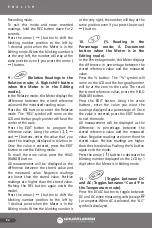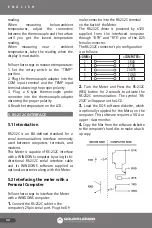
E N G L I S H
43
2. Set the rotary switch to the “Hz” position.
3. Touch the probes to the test points, and
read the display. If the measured frequency
is greater than 200 KHz,
(overload) is
displayed.
4.8 Measuring temperature
WARNINGS:
DO NOT ALLOW
TEMPERATURE PROBES TO CONTACT ANY
LIVE VOLTAGE THAT MAY EXCEED 30
AC V RMS OR 42 AC V PEAK OR 60 DC V.
UNPLUG TEMPERATURE PROBE BEFORE
TAKING MEASUREMENTS OTHER THAN
TEMPERATURE. INSTRUMENT AND/OR
EQUIPMENT DAMAGE COULD RESULT IF THE
ABOVE WARNINGS ARE NOT FOLLOWED.
• This Meter directly measures temperature
using a K-type thermocouple which
optionally supplied with this Meter.
• This Meter displays temperature measured
in degrees either Celsius or Fahrenheit.
NOTE: This Meter automatically defaults
to the Centigrade scale. To measure in
Fahrenheit, toggle the DC/AC button when
the rotary switch is set to TEMP position.
• Repeated sharp flexing can break the
thermocouple lead. To prolong lead life,
avoid sharp bends in the lead, especially
near the connector.
• The temperature measurement range of
the K-type thermocouple supplied with
this Meter is -40°C to +1,370°C (-40°F to
+2,498°F).
Measurement techniques for the
best accuracy.
• Choosing a Proper Thermocouple
Probe. The thermocouple optionally
supplied with this Meter is a bead type
thermocouple, which is designed for
general purpose use. For optimum accuracy,
use the style of probe that is appropriate
for each type of application. For example,
use an air probe for air measurements, a
surface probe for surface measurements,
and an immersion probe for liquid or gel
measurements.
• Thermocouple adapter. The
thermocouple adapter supplied with this
Meter is made from the same materials as
thermocouple wires. To avoid error, it is very
important to use a thermocouple adapter
whose materials match the thermocouple
you are using.
• To reduce errors. Ensure that there is a
good connection between the thermocouple
and the surface you are measuring. For this
purpose, a thermal conducting compound
(such as silicone grease) can be used
between the thermocouple and the surface
you are measuring.
When measuring above-ambient
temperatures, adjust the connection
between the thermocouple and the surface
until you get the highest temperature










































